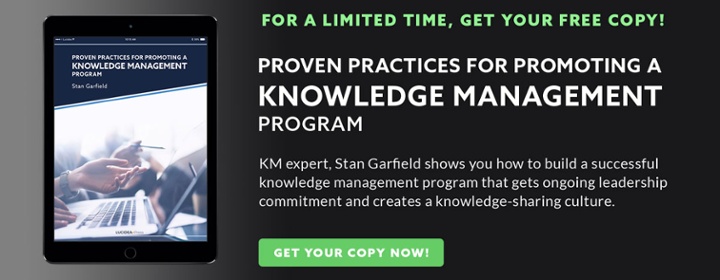
Your organization’s IT department is a key functional partner. You will need to work with them to plan and implement technology projects. Here are detailed suggestions for how to best do this.
- Identify one or more representatives from IT and add them to your team. Treat them as if they are a valued and key direct report, even though they report elsewhere.
- Ask IT to put you, or one of your team members, on their team. Ask them to treat your representative as if they are a valued and key direct report, even though they report elsewhere.
- Hold a regular call or meeting, either weekly or biweekly, to stay in touch, review progress, set priorities, and resolve any problems. Attend each other’s regular staff meetings and calls.
- Convince IT to regularly use the tools being used by the KM program. Ask key IT people to act as champions for these tools and the KM program in general. They can do so through their communications, by providing training, and by encouraging others to follow their example.
- Work together on vendor selection, relations, and support. You should understand and respect IT’s processes and policies, and IT should not make decisions or take action without your agreement and participation.
- Participate in each other’s budgeting. When IT prepares its budget, you should participate, offer suggestions, and agree to the parts that relate to your program. When you prepare the KM budget, IT should participate, offer suggestions, and agree to the parts that relate to IT.
- Work regularly with IT to identify opportunities for integration, improve the user experience, increase functionality, optimize performance, and lower costs. Review existing applications, consider whether to migrate from one vendor to another, discuss whether to buy or build new software, and determine if the design and development processes can be enhanced.
For all applications and systems, work with IT to develop software that can help sell itself in the following ways:
- Be easy and intuitive to use. This makes it simpler to get users to try it and stay with it.
- Offer flexibility in how it can be accessed and used; e.g., online, email, mobile app. This broadens its appeal to a wide range of users, and overcomes typical objections.
- Allow simple and complete integration with other applications; e.g., enterprise search, email, HR systems, etc. This makes it convenient for users.
- Provide rich functionality that is clearly better than other alternatives, and helps people do their work much more readily. New technology needs to be ten times better than what it replaces for most people to change over to using it.
- Stay consistent in user interface and fundamental functionality. This prevents people from looking for alternatives or abandoning it.
Lucidea Press has published my latest book, Proven Practices for Promoting a Knowledge Management Program, which includes more information on appropriate use of technology and partnership with your IT department, as well as additional advice and insights drawn from my career as a KM practitioner



